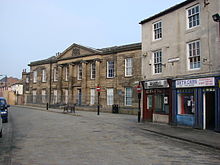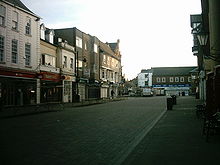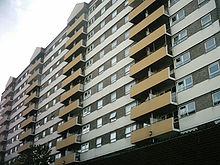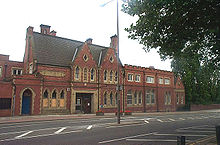- Pontefract
-
Coordinates: 53°41′17″N 1°18′36″W / 53.688°N 1.310°W
Pontefract 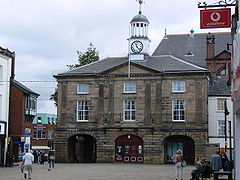
The Old Town Hall
 Pontefract shown within West Yorkshire
Pontefract shown within West YorkshirePopulation 30,000 OS grid reference SE455215 Metropolitan borough City of Wakefield Metropolitan county West Yorkshire Region Yorkshire and the Humber Country England Sovereign state United Kingdom Post town PONTEFRACT Postcode district WF8 Dialling code 01977 Police West Yorkshire Fire West Yorkshire Ambulance Yorkshire EU Parliament Yorkshire and the Humber UK Parliament Normanton, Pontefract and Castleford List of places: UK • England • Yorkshire Pontefract is an historic market town in West Yorkshire, England. Traditionally in the West Riding, near the A1 (or Great North Road), the M62 motorway and Castleford. It is one of the five towns in the metropolitan borough of the City of Wakefield and has a population of 28,250.[1] Pontefract's motto is Post mortem patris pro filio, Latin for "After the death of the father, support the son", a reference to English Civil War Royalist sympathies.
Contents
History
"Pontefract" originates from the Latin for "broken bridge", formed of the elements pons ('bridge') and fractus ('broken'). Pontefract was not recorded in the Domesday Book, but was noted as Pontefracto in 1090, four years after the Domesday Survey.[2] There is a theory that the bridge was one which crossed Wash Burn, a small stream on the north-eastern edge of Pontefract, running alongside what is now Bondgate (the modern-day A645). It would have been important in the town's early days, providing access between Pontefract and other settlements to the north and east, such as York.[3]
The town is situated on an old Roman road (now the A639), described as the "Roman Ridge", which passes south towards Doncaster. The area which is now the town market place was the original meeting place of the Osgoldcross wapentake.[4] There are the remains of an Anglo-Saxon church and cemetery at The Booths, near the castle. The oldest grave dates from around 690. The church is likely to be at Tanshelf, recorded as Tateshale in the Domesday Book but Pontefract is not mentioned.
Pontefract is known for its medieval castle which was built around 1076 by Ilbert de Lacy.[5] The castle was a motte and bailey castle and was later rebuilt in stone.[5] Pontefract Castle dates from Norman times, when it was known as Pomfret. It was built, about 1076 [5] by Ilbert de Lacy. King Richard II was supposedly murdered within the castle walls in 1400. William Shakespeare's play Richard III mentions this incident:[5]
- Pomfret, Pomfret! O thou bloody prison,
- Fatal and ominous to noble peers!
- Within the guilty closure of thy walls
- Richard the second here was hack'd to death;
- And, for more slander to thy dismal seat,
- We give thee up our guiltless blood to drink.[6]
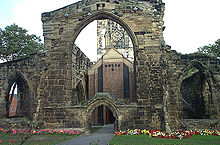 The new church within the old. After the church was damaged during the civil war a new one was built within.
The new church within the old. After the church was damaged during the civil war a new one was built within.
Pontefract suffered throughout the English Civil War. The castle was noted by Oliver Cromwell as "[...] one of the strongest inland garrisons in the kingdom."[5] However, three sieges by the Parliamentarians left the town impoverished and depopulated. After the Third Siege (24 March 1649), Pontefract inhabitants, fearing a fourth, petitioned Parliament for the castle to be demolished. In their view, the castle was a magnet for trouble. On 5 April 1649, demolition began; although efforts were extensive, the crumbling sandstone ruins of the castle remain today and may be visited.[5]
Pontefract was the site of Pontefract Priory, a Cluniac priory founded in 1090 by Robert de Lacy dedicated to St John the Evangelist. The priory was dissolved by royal authority in 1539. The abbey maintained the Chartularies of St John, a collection of historic documents later discovered by Thomas Levett, High Sheriff of Rutland and a native of Yorkshire, among family papers. Levett gave the chartulary to Roger Dodsworth[7] and it was later published by the Yorkshire Archaeological Society, giving scholars a glimpse of life in medieval Yorkshire.[6]
In 2007, a suspected extension of Ferrybridge Henge—a Neolithic henge—was discovered near Pontefract during a survey in preparation for the construction of a row of houses. Once the survey was complete, the construction continued.[8]
Governance
Pontefract is represented by Member of Parliament (MP), Yvette Cooper, a member of the Labour Party for the Normanton, Pontefract and Castleford constituency. Cooper is currently Shadow Home Secretary and Shadow Minister for Women and Equalities. She was elected MP for the Pontefract and Castleford constituency at the 1997 General Election succeeding the Deputy Speaker of the House of Commons, Geoff Lofthouse, who had retired. (Pontefract and Castleford was merged with the Normanton constituency in a boundary change before the 2010 General Election.)
In her maiden speech, Cooper said: 'The House must not misunderstand me. It is true that my constituency is plagued by unemployment, but I represent hard-working people who are proud of their strong communities and who have fought hard across generations to defend them. They are proud of their socialist traditions, and have fought for a better future for their children and their grandchildren. In the Middle Ages, that early egalitarian, the real Robin Hood, lived, so we maintain, in the Vale of Wentbridge to the south of Pontefract. It was a great base from which to hassle the travelling fat cats on the Great North Road.'
The seat which has a history of mining and industry, has consistently returned Labour MPs at General Elections. Yvette Cooper polled 48.1% of the vote in the 2010 General Election.
The town is divided into two for Local Government purposes, Pontefract North and Pontefract South, and is currently represented by 3 Labour and 3 Conservatives Councilors.
The local ex-miner and former local NUM branch leader Geoff Lofthouse was MP for the former constituency of Pontefract and Castleford from 1978 to 1997. Lofthouse was made a peer on 11 June 1997: he is now known as Geoffrey Lofthouse, Baron Lofthouse of Pontefract.
Pontefract today
Pontefract has been a market town since the Middle Ages; the market days are Wednesday and Saturday, with a smaller market on Fridays. The covered market is open all week, except Thursday afternoons and Sundays. Thursday afternoon is half-day closing in the town. The town is called Ponte/Ponty by its citizens and sometimes jokingly referred to as Ponte Carlo, in reference to Monte Carlo. This theme is continued in the name of bars in the xscape complex, Glasshoughton between Pontefract and Castleford, referred to locally as 'Cas Vegas'.
Pontefract's deep, sandy soil makes it one of the few British places in which liquorice can be successfully grown. The town has a liquorice-sweet industry; and the famous Pontefract Cakes are produced, though the liquorice plant itself is no longer grown there. The town's two liquorice factories are owned by Haribo (formerly known as Dunhills) and Monkhill Confectionery (part of the Cadbury's Group - formerly known as Wilkinson's), respectively. A Liquorice Festival is held annually. Poet laureate Sir John Betjeman wrote a poem entitled "The Licorice Fields at Pontefract".
Close by is the coal-fired power station at Ferrybridge. There are Tesco and Morrisons supermarkets, and most recently Asda, which changed hands from Kwik Save. The schools in the town are Carleton Community High School, in Carleton, and The King's School, on Mill Hill Lane; both are comprehensive schools, for ages 11–16.
Pontefract is locally renowned for its numerous pubs. One of the oldest buildings, dating from the 16th century and previously used as a shop, was turned into a pub in the 1990s, called the Counting House.
Pontefract has the largest circular flat racecource in Europe.
Pontefract General Infirmary is a large general hospital, beneath which is an old hermitage, open to the public on certain days. It is the place at which serial killer Harold Shipman began to murder his elderly patients. The hospital has been rebuilt and reopened in 2010. Pontefract Museum, from which the hermitage schedule can be obtained, is in the town centre, housed in the former Carnegie library. There is now a modern library building. Pontefract has three railway stations: Pontefract Baghill, on the Dearne Valley Line, which connects York and Sheffield; and Pontefract Monkhill and Pontefract Tanshelf, which connects with Leeds and Wakefield.
Pontefract has a park with a racecourse on the outskirts of town.
Entertainment
Pontefract's local newspaper is the Pontefract and Castleford Express. According to local hoteliers, Pontefract is known for its 'down-to-earth' nightlife, and has one of the highest concentrations of public houses in the UK.[9] Venues include Big Fellas, the Counting House, the Elephant, the Green Dragon, the Tap and Barrel, Wetherspoons, the Malt Shovel, and the Blackmoor Head.
Sports
The town is home to many major sports including cricket and football. Its two most famous institutions are horse racing at Pontefract Racecourse and Featherstone Rovers, the area's professional rugby league club.
Pontefract Racecourse is the longest continuous circuit in Europe at two miles and 125 yards (3,300 m).[10] It stages flat racing between the end of March and the end of October. Nearer to the town centre are the Valley Gardens, with a love garden, an aviary, and an avenue of cherry trees, which bloom in the spring. Although the trees continue to attract admiration, the gardens have become quite depleted and the aviary has been vandalised. Pontefract swimming pool is on Stuart Road.
Life in Pontefract was satirised by J. S. Fletcher in his book The Town of Crooked Ways, whose title is held to have been purposefully ambiguous, being a reference either to the medieval layout of the town, or to the behaviour of its inhabitants. More recently, Pontefract has seen its share of scandal, in the form of the Poulson affair, in the 1960s. Pontefract is home to North-East-Wakefield College (more commonly known as NEW College), which has ranked in the top 25 colleges in the United Kingdom for the past few years. Pontefract is also home to All Saints Church, built over ruins of an original church, which was destroyed during the three Civil War sieges of Pontefract Castle; the church's bell tower staircase is the famous 'double helix'.
Pontefract has its own non league football club Pontefract Collieries F.C. who were founded in 1958 and play adjacent to the former Prince of Wales Colliery off Beechnut Lane. "Ponte Colls" play in the Northern Counties East Football League
Oscar Barrington is one of the famous figures in Pontefract for being a professional liquorice taster.
Location grid

Castleford 
Featherstone 
Knottingley  Pontefract
Pontefract 

Hemsworth See also
References
- ^ "Census 2001 : Urban Areas : Table KS01 : Usual Resident Population" (Excel). Office for National Statistics. http://www.statistics.gov.uk/statbase/Expodata/Spreadsheets/D8271.xls. Retrieved 2010-10-02.
- ^ 'Oxford Dictionary of British Place-Names', A.D. Mills, Oxford University Press.
- ^ 'Brewer's Britain & Ireland', John Ayto and Ian Crofton, Weidenfeld & Nicholson.
- ^ David Hey, Medieval South Yorkshire
- ^ a b c d e f BBC | Yorkshires Castles - Pontefract Castle
- ^ a b "BBC - h2g2 - Yorkshire's Castles: Pontefract Castle". www.bbc.co.uk. http://www.bbc.co.uk/dna/h2g2/A2350108. Retrieved 2008-07-22.
- ^ Collectanea Topographica Et Genealogica, Vol. II, Frederic Madden, Bulkeley Bandinel, John Gough, John Bowyer Nichols And Son, London, 1835
- ^ "Ferrybridge Henge extension discovered in West Yorkshire". Culture24. 2007-08-30. http://www.culture24.org.uk/history+%2526+heritage/archaeology/art50167. Retrieved 2009-12-07.
- ^ http://www.pontefracthotels.co.uk/
- ^ "Course Details - Pontefract Racecourse". http://www.pontefract-races.co.uk/course-details/. Retrieved 2008-07-04.
External links
- NEW College
- Local history
- Pontefract Young Farmers
- Pontefract Liquorice Trust
- Pontefract Races
- Pontefract Collieries F.C.
- Priory of St. John of Pontefract, British History Online
- St. Giles Pantomime Society
- Pontefract and Castleford Express
Ceremonial county of West Yorkshire Metropolitan districts Major settlements - Batley
- Bingley
- Bradford
- Brighouse
- Castleford
- Cleckheaton
- Denholme
- Dewsbury
- Elland
- Farsley
- Featherstone
- Garforth
- Guiseley
- Halifax
- Hebden Bridge
- Hebden Royd
- Heckmondwike
- Hemsworth
- Holmfirth
- Horsforth
- Huddersfield
- Ilkley
- Keighley
- Knottingley
- Leeds
- Meltham
- Mirfield
- Morley
- Mytholmroyd
- Normanton
- Ossett
- Otley
- Pontefract
- Pudsey
- Rothwell
- Shipley
- Silsden
- South Elmsall
- Sowerby Bridge
- Todmorden
- Wakefield
- Warley Town
- Wetherby
- Yeadon
See also: List of civil parishes in West Yorkshire
Topics - Parliamentary constituencies
- West Yorkshire Joint Services
- Monastic houses
- Museums
- Windmills
Categories:- Pontefract
- Geography of Wakefield
- Market towns in West Yorkshire
- Towns in West Yorkshire
Wikimedia Foundation. 2010.


